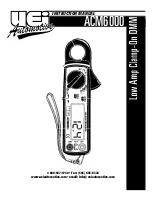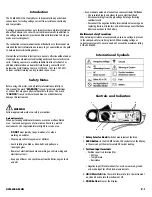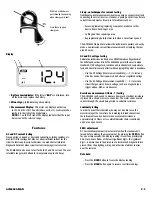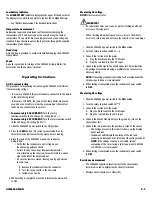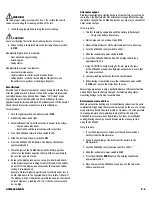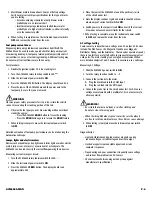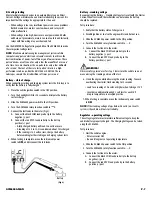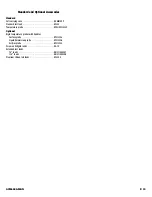
ACM6000-MAN
P. 6
7. Most blower motors draws about 25 amps at battery voltage.
Verify normal current draw specifications for the type of motor
you are testing.
• Excessive amperage indicates a faulty blower motor
probably due to an internal short
• Insufficient amperage indicates a faulty blower motor
probably due to high electrical resistance, either internally
or in the connector paths
8. When testing is complete move the instrument power switch to
OFF
, and remove the meter from the wire.
Fuel pump current draw
Diagnosing fuel pump problems can sometimes be difficult. The
ACM6000 can be used to make a quick check for fuel pump current
draw during cranking. A fuel pump related problem possibly exists if
current flow is 2 amps or less during cranking. Additional testing may
be necessary if current flow is more than 2 amps.
Test procedure:
1. Disable the ignition system. This is a cranking test.
2. Turn the ACM6000 rotary function switch to 20A .
3. Slide the instrument power switch to
ON
.
4. Press the ACM6000 ZERO button. The display should read 00.0.
5. Place the jaws of the ACM6000 around the power wire to the
fuel pump. Be sure the jaws are closed.
WARNING!
Observe proper safety procedures for step 6. Be certain the vehicle
cannot move during the cranking portion of this test.
6. Observe the fuel pump current draw reading while an assistant
cranks the engine:
• Press the ACM6000
HOLD
button to freeze the reading
• Press the
HOLD
button again to release the
HOLD
feature
7. When testing is complete, move the instrument power switch
to
OFF
.
Detailed evaluation of fuel pump performance can be made using the
Automotive Labscope.
Lamps, lights and electric motors
Devices such as headlamps, stop lights and interior lights as well as electric
motors (wiper, seat, mirror, etc.) draw current at a steady rate. The
ACM6000 can be used to verify the current flow powering these devices.
Measuring current in suspect circuit:
1. Turn the ACM6000 rotary function switch to 200A .
2. Slide the instrument power switch to
ON
.
3. Press the ACM6000
ZERO
button. The display should read
approximately 00.0.
4. Place the jaws of the ACM6000 around the positive (+) wire
of the circuit under test.
5. Note the display readout. Lights and motors should not draw
whole amps of current until switched
ON
.
6. Switch power to the suspect circuit
ON
and verify that current
draw does not exceed normal limits for that circuit.
7. When testing is complete, move the instrument power switch
to
OFF
, and remove the meter from the wire.
AC voltage testing
Some sensors produce their own voltage as an AC output. AC devices
include: The ABS Sensor, the Magnetic Crank Sensor, Magnetic
Distributor Pickup, and the Alternator. These devices operate at speeds
that are too fast for a meter to be able to give exact measurements of
each pulse. The meter reading is an averaged measurement. When
more detailed analysis of an AC device it is necessary, use a Labscope.
Measuring AC Voltage:
1. Slide the ACM6000 power switch to
ON
.
2. Turn the rotary function switch to V.
3. Connect the test leads to the meter.
A. Plug the black lead into the COM input
B. Plug the red lead into the V
W
˚F input
4. Connect the probe tips to the circuit under test. For AC sensor
voltage measurements with a multimeter, it is not necessary to
observe polarity.
WARNING!
• Be certain that wires and leads, as well as clothing and
hands are clear of moving parts
• When checking ABS wheel speed sensors be sure the wheels
are free to rotate and will not move the vehicle or cause damage
5. When testing is complete move the instrument power switch
to
OFF
.
Diagnostic tips:
• Heat and vibration can degrade sensor magnets, causing
reduced voltage or erratic voltage and current output
• Cracked magnets create unstable signals and erratic
computer responses
• Frayed wiring and poor connections frequently cause voltage
and current flow problems on AC sensors
• Check clearance between magnet and pickup against
manufacturer’s specifications

